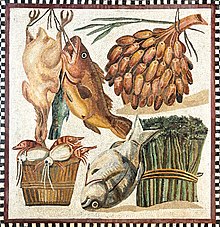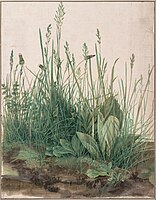With origins in the Middle Ages and Ancient Greco-Roman art, still-life painting emerged as a distinct genre and professional specialization in Western painting by the late 16th century, and has remained significant since then. A still-life form gives the artist more freedom in the arrangement of elements within a composition than do paintings of other types of subjects such as landscape or portraiture. Still life, as a particular genre, began with Netherlandish painting of the 16th and 17th centuries, and the English term still life derives from the Dutch word stilleven. Early still-life paintings, particularly before 1700, often contained religious and allegorical symbolism relating to the objects depicted. Some modern still-life work breaks the two-dimensional barrier and employs three-dimensional mixed media, and uses found objects, photography, computer graphics, as well as video and sound.
The term includes the painting of dead animals, especially game. Live ones are considered animal art, although in practice they were often painted from dead models. The still-life category also shares commonalities with zoological and especially botanical illustration, where there has been considerable overlap among artists. Generally a still life includes a fully depicted background, and puts aesthetic rather than illustrative concerns as primary.
Still life occupied the lowest rung of the hierarchy of genres, but has been extremely popular with buyers. As well as the independent still-life subject, still-life painting encompasses other types of painting with prominent still-life elements, usually symbolic, and "images that rely on a multitude of still-life elements ostensibly to reproduce a 'slice of life'". The trompe-l'œil painting, which intends to deceive the viewer into thinking the scene is real, is a specialized type of still life, usually showing inanimate and relatively flat objects.
Antecedents and development
Still-life paintings often adorn the interior of ancient Egyptian tombs. It was believed that food objects and other items depicted there would, in the afterlife, become real and available for use by the deceased. Ancient Greek vase paintings also demonstrate great skill in depicting everyday objects and animals. Peiraikos is mentioned by Pliny the Elder as a panel painter of "low" subjects, such as survive in mosaic versions and provincial wall-paintings at Pompeii: "barbers' shops, cobblers' stalls, asses, eatables and similar subjects".

Similar still life, more simply decorative in intent, but with realistic perspective, have also been found in the Roman wall paintings and floor mosaics unearthed at Pompeii, Herculaneum and the Villa Boscoreale, including the later familiar motif of a glass bowl of fruit. Decorative mosaics termed "emblema", found in the homes of rich Romans, demonstrated the range of food enjoyed by the upper classes, and also functioned as signs of hospitality and as celebrations of the seasons and of life.
By the 16th century, food and flowers would again appear as symbols of the seasons and of the five senses. Also starting in Roman times is the tradition of the use of the skull in paintings as a symbol of mortality and earthly remains, often with the accompanying phrase Omnia mors aequat (Death makes all equal). These vanitas images have been re-interpreted through the last 400 years of art history, starting with Dutch painters around 1600.

The popular appreciation of the realism of still-life painting is related in the ancient Greek legend of Zeuxis and Parrhasius, who are said to have once competed to create the most lifelike objects, history’s earliest descriptions of trompe-l'œil painting. As Pliny the Elder recorded in ancient Roman times, Greek artists centuries earlier were already advanced in the arts of portrait painting, genre painting and still life. He singled out Peiraikos, "whose artistry is surpassed by only a very few...He painted barbershops and shoemakers’ stalls, donkeys, vegetables, and such, and for that reason came to be called the ‘painter of vulgar subjects’; yet these works are altogether delightful, and they were sold at higher prices than the greatest [paintings] of many other artists."
Middle Ages and Early Renaissance
By 1300, starting with Giotto and his pupils, still-life painting was revived in the form of fictional niches on religious wall paintings which depicted everyday objects. Through the Middle Ages and the Renaissance, still life in Western art remained primarily an adjunct to Christian religious subjects, and convened religious and allegorical meaning. This was particularly true in the work of Northern European artists, whose fascination with highly detailed optical realism and symbolism led them to lavish great attention on their paintings' overall message. Painters like Jan van Eyck often used still-life elements as part of an iconographic program.

In the late Middle Ages still-life elements, mostly flowers but also animals and sometimes inanimate objects, were painted with increasing realism in the borders of illuminated manuscripts, developing models and technical advances that were used by painters of larger images. There was considerable overlap between the artists making miniatures for manuscripts and those painting panels, especially in Early Netherlandish painting. The Hours of Catherine of Cleves, probably made in Utrecht around 1440, is one of the outstanding examples of this trend, with borders featuring an extraordinary range of objects, including coins and fishing-nets, chosen to complement the text or main image at that particular point. Flemish workshops later in the century took the naturalism of border elements even further. Gothic millefleur tapestries are another example of the general increasing interest in accurate depictions of plants and animals. The set of The Lady and the Unicorn is the best-known example, designed in Paris around 1500 and then woven in Flanders.
The development of oil painting technique by Jan van Eyck and other Northern European artists made it possible to paint everyday objects in this hyper-realistic fashion, owing to the slow drying, mixing, and layering qualities of oil colours. Among the first to break free of religious meaning were Leonardo da Vinci, who created watercolour studies of fruit (around 1495) as part of his restless examination of nature, and Albrecht Dürer who also made precise coloured drawings of flora and fauna.
Petrus Christus’ portrait of a bride and groom visiting a goldsmith is a typical example of a transitional still life depicting both religious and secular content. Though mostly allegorical in message, the figures of the couple are realistic and the objects shown (coins, vessels, etc.) are accurately painted but the goldsmith is actually a depiction of St. Eligius and the objects heavily symbolic. Another similar type of painting is the family portrait combining figures with a well-set table of food, which symbolizes both the piety of the human subjects and their thanks for God’s abundance. Around this time, simple still-life depictions divorced of figures (but not allegorical meaning) were beginning to be painted on the outside of shutters of private devotional paintings. Another step toward the autonomous still life was the painting of symbolic flowers in vases on the back of secular portraits around 1475. Jacopo de’ Barbari went a step further with his Still Life with Partridge, Iron Gloves, and Crossbow Arrows (1504), among the earliest signed and dated trompe-l'œil still-life paintings, which contains minimal religious content.

Various vessels in the border of an illuminated book of hours for Engelbert of Nassau, Flemish artist, 1470s
| 
Detail of one of The Lady and the Unicorn millefleur tapestries, c. 1500
| 
Albrecht Dürer, The Large Piece of Turf, 1503
| 
Jacopo de' Barbari, Still-Life with Partridge and Gauntlets (1504), a very early independent still life, perhaps the back or cover for a portrait
|
|---|
Source From Wikipedia
没有评论:
发表评论